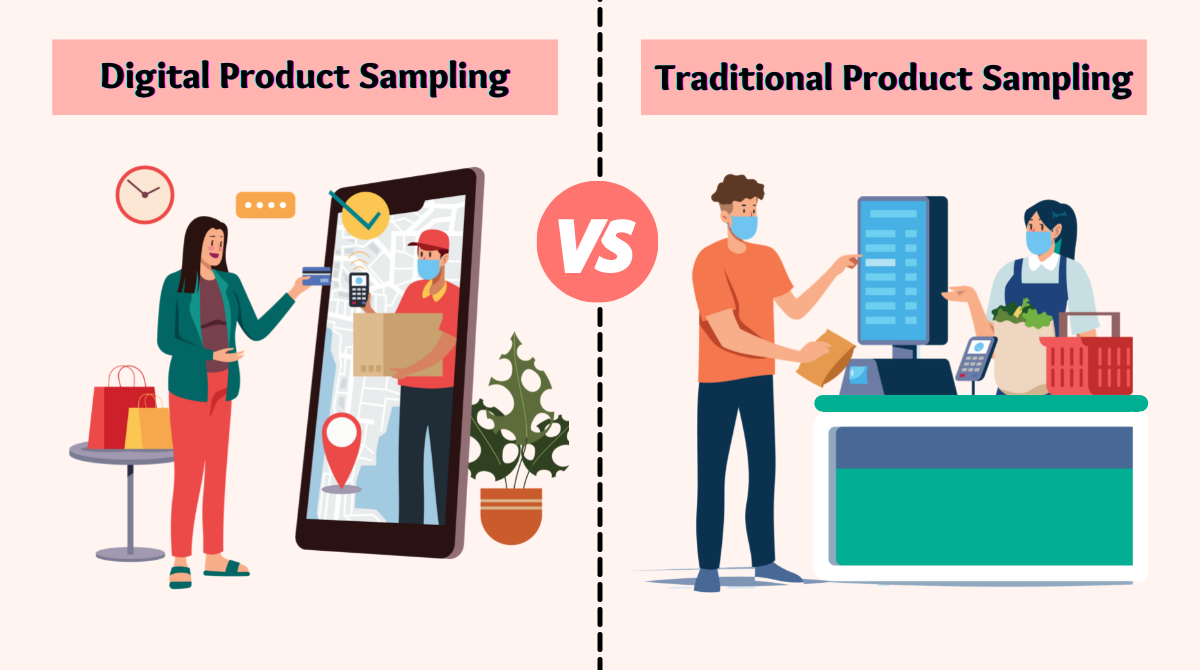In today's oversaturated CPG market, brands face a critical challenge: how to stand out, connect with consumers, and drive sales amidst fierce competition. With countless products competing for limited attention and shelf space, many brands struggle to differentiate themselves effectively.
The consequences of failing to adapt are severe. As e-commerce and private labels gain ground, traditional CPG companies risk becoming obsolete. Shifting consumer preferences towards sustainability and personalization further intensifies the pressure.
However, there's a path forward. By embracing innovative marketing strategies, CPG brands can not only survive but thrive. This guide explores cutting-edge trends and techniques reshaping CPG marketing in 2024. From data-driven customer insights to emerging technologies, we'll show you how to create campaigns that resonate with modern consumers and deliver tangible results.
Understanding CPG Marketing
CPG marketing refers to the specific strategies and tactics used to promote Consumer Packaged Goods (CPG). These are products that consumers use regularly and need frequent replacement, such as food, beverages, household cleaning products, and personal care items.
Why Is CPG Marketing Important?
CPG marketing is crucial due to the sector's massive economic impact and highly competitive nature. The CPG industry is a cornerstone of the global economy, representing trillions of dollars in annual sales and touching the lives of consumers worldwide. Here's why CPG marketing is of paramount importance:
- Economic Significance:
The CPG sector is a major contributor to the global economy. As illustrated in the table below, the market is projected to experience substantial growth over the next decade.
| Year | Market Size (USD Billion) | CAGR |
| 2022 | 2,132.1 | - |
| 2032 | 3,171.11 (estimated) | 4.1% |
- Fierce Competition:
With numerous brands vying for consumer attention in each product category, effective marketing is essential for standing out in a crowded marketplace.
- Rapidly Changing Consumer Preferences:
CPG companies must stay attuned to evolving consumer trends, health concerns, and sustainability issues, adapting their marketing strategies accordingly.
- Brand Loyalty Building:
Effective marketing helps create and maintain brand loyalty, which is crucial in an industry where consumers have multiple options.
- New Product Introduction:
The CPG sector constantly introduces new products. Marketing plays a vital role in educating consumers about these innovations and driving adoption.
- Omnichannel Presence:
With the rise of e-commerce and digital platforms, CPG marketing must effectively reach consumers across various channels, both online and offline.
- Data-Driven Decisions:
Modern CPG marketing leverages big data and analytics to understand consumer behavior and optimize marketing strategies, making it a critical driver of business success.
- Global Reach:
Many CPG brands operate internationally, requiring sophisticated marketing strategies that can be adapted to diverse cultural contexts and consumer preferences.
- Sustainability and Social Responsibility:
Marketing plays a crucial role in communicating a brand's commitment to sustainability and social responsibility, which are increasingly important to consumers.
- Retailer Relationships:
Effective marketing not only targets consumers but also helps in building and maintaining relationships with retailers, which is crucial for product placement and visibility.
Given the projected growth of the CPG market, the importance of strategic and effective marketing in this sector cannot be overstated. It is a key driver of growth, innovation, and competitive advantage in this dynamic and expansive industry.
Effective CPG Marketing Strategies
In today's competitive CPG landscape, implementing effective marketing strategies is essential for brand success. The following approaches can help CPG companies connect with consumers, drive growth, and stay ahead in an ever-evolving market:
1. Hyper-Personalization through AI
Leverage artificial intelligence and machine learning to deliver highly personalized experiences:
- Implement AI-powered product recommendations
- Use predictive analytics for tailored marketing messages
- Develop dynamic pricing models based on individual consumer behavior
Studies show that nearly 71% of CPG companies have invested in advanced analytics for personalization.
2. Sustainability-Driven Campaigns
Capitalize on growing consumer interest in eco-friendly products:
- Launch limited-edition sustainable product lines
- Create consumer education campaigns about environmental impact
- Implement circular economy initiatives (e.g., packaging return programs)
3. Micro-Influencer Collaborations
Harness the power of niche influencers for authentic brand promotion:
- Partner with micro-influencers in specific product categories
- Create co-branded product lines with relevant influencers
- Develop influencer-led content series showcasing product uses
4. Immersive Storytelling Experiences
Use innovative storytelling techniques to build emotional connections:
- Develop interactive brand histories using augmented reality
- Create emotional connections through storytelling
- Launch episodic content series highlighting brand values and mission
5. Social Commerce Integration
Capitalize on the growing trend of in-platform shopping:
- Implement shoppable posts and livestreams on social media
- Develop exclusive social media-only product launches
- Create interactive shopping experiences within social apps
6. Voice Search Optimization
Adapt to the rise of voice-activated devices and searches:
- Optimize product descriptions for natural language queries
- Develop voice-activated shopping skills for smart speakers
- Create audio content for voice search discovery
7. Subscription-Based Models
Build recurring revenue streams and foster brand loyalty:
- Launch curated product subscription boxes
- Offer auto-replenishment services for consumable goods
- Develop tiered subscription models with exclusive benefits
8. Cause Marketing Initiatives
Align brand values with social causes to resonate with conscious consumers:
- Partner with non-profits for limited-edition product lines
- Implement purchase-driven donation programs
- Launch awareness campaigns for relevant social issues
9. Augmented Reality Product Experiences
Enhance the shopping experience with AR technology:
- Develop AR apps for virtual product try-on
- Create AR-enhanced packaging for interactive product information
- Implement AR-powered in-store navigation and product locators
10. Community-Driven Innovation
Involve consumers in the product development process:
- Launch crowdsourcing campaigns for new product ideas
- Implement beta testing programs for loyal customers
- Create online communities for product feedback and ideation
Emerging Trends Reshaping CPG Marketing
While sustainability and personalization are at the forefront of CPG marketing, several emerging trends are fundamentally reshaping the industry:
- Sustainability Beyond Packaging
- Circular economy initiatives: Brands implementing take-back programs and upcycling initiatives
- Carbon-neutral products: Companies offsetting emissions throughout the entire supply chain
- Regenerative agriculture: Sourcing ingredients from farms that improve soil health and biodiversity
- Hyper-Personalization
- AI-driven products: Recommendations based on individual preferences and behaviors
- Custom formulations: Allowing consumers to create personalized versions of products
- Personalized packaging: Offering customizable labels or designs for gifting or personal use
- Health and Wellness Integration
- Functional ingredients: Incorporating adaptogens, probiotics, and other health-boosting elements
- Mental health focus: Products designed to reduce stress or improve sleep
- Transparency in ingredients: QR codes linking to detailed sourcing information
- Direct-to-Consumer (D2C) Expansion
- Subscription models for recurring purchases
- Virtual consultations for product selection (e.g., skincare routines)
- Exclusive D2C product lines not available in traditional retail
These trends are reshaping the CPG industry by:
- Shifting consumer expectations towards more sustainable and personalized products
- Blurring the lines between CPG, tech, and wellness industries
- Requiring brands to invest in new technologies and supply chain innovations
- Creating opportunities for niche products and micro-brands to gain market share
Key Elements of Successful CPG Marketing
Effective marketing in the consumer packaged goods industry requires a multifaceted approach that combines deep consumer understanding with innovative strategies. The following key elements are crucial for success in this competitive landscape:
a) Brand Development and Positioning
Effective brand positioning sets a CPG brand apart from competitors. Strategies include:
- Identifying target audience and defining brand values
- Communicating unique benefits and implementing innovative packaging
- Highlighting unique selling propositions (USPs) in all marketing communications
- Developing a consistent brand voice and visual identity across all touchpoints
Creating a strong, recognizable brand identity for CPG products is essential. This involves differentiating products from competitors in a crowded marketplace.
b) Consumer Insights and Market Research
Understanding consumer behavior and preferences is crucial for CPG marketing success. Utilize techniques such as surveys, focus groups, social media analysis, and platforms like Peekage for in home product testing and real-time feedback..
This research helps in understanding target audience needs, preferences, and behaviors to inform marketing decisions.
c) Product Development and Innovation
Innovation is key to staying relevant in the CPG market. The new product development process includes:
- Idea Generation
- Market Research
- Concept Development
- Product Design
- Testing and Validation
- Launch
- Post-launch evaluation and iteration
Successful product launches often involve addressing unmet consumer needs or creating new market categories. Consider sustainability and eco-friendly materials in product development to meet growing consumer demand for environmentally responsible options.
d) Packaging Design and Pricing Strategy
Developing attractive, informative packaging that stands out on store shelves and communicates key product benefits is crucial. This goes hand in hand with determining optimal price points that balance competitiveness with profitability.
e) Retail Partnerships
Collaborating effectively with retailers is crucial for CPG's success. Key aspects include:
- Developing strong relationships with key retail partners
- Negotiating favorable shelf space and product placement
- Collaborating on joint marketing initiatives and promotions
- Sharing consumer insights and market trends for mutual benefit
- Ensuring consistent brand representation across different retail environments
- Developing exclusive or limited-edition products for specific retailers
- Implementing efficient inventory management and restocking processes
f) Digital Marketing Strategies
Digital marketing is essential for reaching today's tech-savvy consumers. Key components include:
- SEO tactics: Keyword research, on-page optimization, and content marketing
- Social media strategies: Engaging content, community building, and influencer partnerships
- Email marketing: Personalized campaigns and newsletters
- PPC advertising: Targeted ads on search engines and social media platforms
- E-commerce optimization: User-friendly online shopping experiences and mobile-first design
- Data analytics: Utilizing consumer data for personalized marketing and product recommendations
g) Omnichannel Marketing
This involves implementing an integrated approach to reach consumers across various channels, including brick-and-mortar stores, e-commerce platforms, and direct-to-consumer strategies.
h) Customer Relationship Management (CRM)
Develop strong customer relationships through:
- Loyalty programs and rewards
- Personalized communication
- Excellent customer service and support
- Community building and user-generated content initiatives
By focusing on these key elements, CPG brands can create comprehensive marketing strategies that drive growth, build customer loyalty, and maintain a competitive edge in the market.
Overcoming Common CPG Marketing Challenges
In today's rapidly evolving consumer goods landscape, CPG marketers face a multitude of challenges that require innovative solutions and strategic thinking. The following key issues demand attention and creative problem-solving to ensure continued success in a competitive market:
- Standing Out in a Crowded Market:
- Develop innovative packaging designs that catch the eye
- Create unique product features that address unmet consumer needs
- Craft compelling brand narratives that resonate with target audiences
- Leverage sustainability as a differentiator
- Adapting to Rapidly Changing Consumer Preferences:
- Implement agile marketing strategies for quick pivots
- Utilize real-time data analytics for trend identification
- Engage in ongoing consumer research and social listening
- Foster a culture of innovation within the organization
- Balancing Online and Offline Presence:
- Develop an integrated omnichannel marketing approach
- Create seamless customer experiences across all touchpoints
- Utilize technology to bridge the gap between digital and physical retail
- Implement click-and-collect or ship-from-store options
- Managing Supply Chain Disruptions:
- Diversify suppliers to reduce dependency risks
- Invest in predictive analytics for demand forecasting
- Maintain transparent communication with customers about potential issues
- Develop contingency plans for various disruption scenarios
- Consider nearshoring or reshoring options to reduce vulnerabilities
- Navigating Increasing Regulatory Pressures:
- Stay informed about changing regulations in different markets
- Ensure compliance with labeling and ingredient disclosure requirements
- Adapt product formulations to meet evolving health and safety standards
- Proactively address sustainability and ethical sourcing concerns
- Maximizing ROI on Marketing Spend:
- Implement data-driven attribution models to assess campaign effectiveness
- Optimize marketing mix based on performance metrics
- Leverage AI and machine learning for more targeted advertising
- Focus on customer lifetime value rather than short-term sales
- Building Brand Loyalty in a Price-Sensitive Market:
- Develop value-added services or content to enhance the product offering
- Create emotional connections through purpose-driven marketing
- Implement personalized loyalty programs that offer meaningful rewards
- Foster community engagement through social media and events
Measuring CPG Marketing Success
Track these key performance indicators (KPIs) to ensure your marketing efforts are effective:
| KPI | Description | Importance |
| Sales Growth | Year-over-year increase in revenue | Indicates overall business health and market acceptance |
| Market Share | Percentage of total market sales | Reflects competitive position and brand strength |
| Customer Acquisition Cost (CAC) | Cost to acquire a new customer | Helps optimize marketing spend and channel effectiveness |
| Customer Lifetime Value (CLV) | Total value a customer brings over their lifetime | Guides customer retention strategies and marketing budget allocation |
| Brand Awareness | Percentage of target audience familiar with brand | Measures marketing reach and potential for growth |
| Return on Marketing Investment (ROMI) | Revenue generated per dollar spent on marketing | Demonstrates marketing efficiency and helps in budget planning |
| Product Turn Rate | How quickly inventory is sold and replaced | Indicates product demand and supply chain efficiency |
| Net Promoter Score (NPS) | Measure of customer loyalty and satisfaction | Predicts business growth through customer recommendations |
| Digital Engagement Metrics | Social media interactions, website traffic, email open rates | Assesses the effectiveness of digital marketing efforts |
| In-Store Metrics | Foot traffic, conversion rates, average transaction value | Evaluates performance in physical retail environments |
Additional Considerations for Effective Measurement:
- Segmentation: Analyze KPIs by product category, customer segment, and geographic region for more targeted insights.
- Competitive Benchmarking: Compare your KPIs against industry averages and top competitors to gauge relative performance.
- Leading Indicators: Identify and track early warning signs that may impact future performance, such as changes in consumer sentiment or emerging trends.
- Attribution Modeling: Implement multi-touch attribution models to understand the impact of different marketing channels on conversions.
- Real-Time Dashboards: Utilize data visualization tools to create real-time dashboards for quick decision-making.
- Predictive Analytics: Leverage AI and machine learning to forecast future performance based on historical data and market trends.
- Customer Feedback Loop: Incorporate qualitative feedback from customers to provide context to quantitative metrics.
You can easily gain a holistic view of your marketing performance by tracking and analyzing the above-mentioned metrics
The Future of CPG Marketing: Emerging Technologies
Several technologies are poised to revolutionize CPG marketing, offering new ways to engage consumers, optimize operations, and gain competitive advantages:
- Augmented Reality (AR) and Virtual Reality (VR):
- Virtual product try-ons and immersive brand experiences
- In-store navigation and product information overlays
- Virtual packaging prototyping and testing
- Internet of Things (IoT):
- Smart packaging with NFC tags for product authentication and information
- Automated replenishment systems
- Real-time inventory tracking and demand forecasting
- Blockchain:
- Enhancing supply chain transparency
- Authenticity verification for premium and luxury CPG products
- Secure and efficient loyalty programs
- 5G Networks:
- More sophisticated mobile marketing
- Real-time personalization at scale
- Enhanced video and interactive content delivery
- Biometrics:
- Personalized product recommendations based on physiological data
- Emotion recognition for adaptive marketing
- Quantum Computing:
- Complex market simulations and forecasting
- Optimization of supply chain and logistics
Implementation Strategies:
- Start with pilot programs to test new technologies before full-scale adoption
- Collaborate with tech startups and innovation hubs for cutting-edge solutions
- Invest in employee training to leverage new technologies effectively
- Prioritize data privacy and security in all technology implementations
- Focus on technologies that add tangible value to the customer experience
Challenges to Consider:
- Integration with existing systems and processes
- Ensuring return on investment for new technology adoption
- Addressing potential consumer concerns about data privacy and security
- Keeping pace with the rapidly evolving technological landscape
Strategically adopt and integrate these emerging technologies to create more engaging customer experiences, streamline operations, and gain valuable insights to drive growth in an increasingly digital marketplace.
Conclusion
In the dynamic world of consumer packaged goods, successful marketing requires a blend of creativity, data-driven insights, and adaptability. By embracing the strategies and trends outlined in this guide, your brand can navigate the challenges of the CPG landscape and build lasting connections with consumers.
Remember, the key to success lies in understanding your target audience, leveraging the right technologies, and continuously innovating your approach. Whether you're an established CPG giant or a startup disrupting the market, the principles of effective CPG marketing remain the same: deliver value, build trust, and stay ahead of the curve.
As you refine your CPG marketing strategy, consider leveraging platforms like Peekage to gain valuable consumer insights through targeted product sampling and research campaigns. By understanding your audience's needs and preferences firsthand, you'll be well-equipped to create marketing strategies that truly resonate in the ever-evolving consumer goods market.
FAQs
1. How does CPG make money?
CPG makes money primarily through the sale of consumer goods. They earn revenue by manufacturing and selling products such as food, beverages, personal care items, and household products to retailers and directly to consumers.
2. Is CPG b2b or B2C?
CPG (Consumer Packaged Goods) companies operate in both B2B (business-to-business) and B2C (business-to-consumer) markets. They sell products to retailers (B2B) who then sell to consumers (B2C).
3. What are some common marketing strategies used by CPG companies?
CPG companies often use a mix of digital marketing, traditional advertising, promotions, influencer partnerships, and in-store displays to reach and engage consumers.
4. How do CPG companies use data in their marketing efforts?
CPG companies leverage data analytics to understand consumer behavior, optimize pricing strategies, personalize marketing campaigns, and improve product development and supply chain efficiency.
References
- Predictive Analytics, Treasure Data,
https://www.treasuredata.com/glossary/what-is-predictive-analytics/ - Redefine the omnichannel approach, Mckinsey,
https://www.mckinsey.com/capabilities/operations/our-insights/redefine-the-omnichannel-approach-focus-on-what-truly-matters - How to build brand loyalty, Mailchimp,
https://mailchimp.com/resources/build-brand-loyalty/ - Marketing Insights: Understanding Trends to Drive Results, Media Tool,
https://mediatool.com/blog/marketing-insights - Marketing Strategy: What It Is and How to Create One, Coursera,
https://www.coursera.org/articles/marketing-strategy




